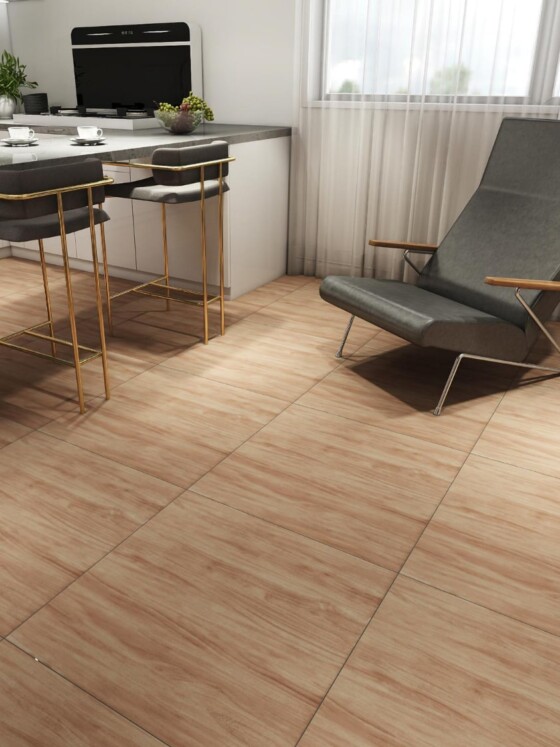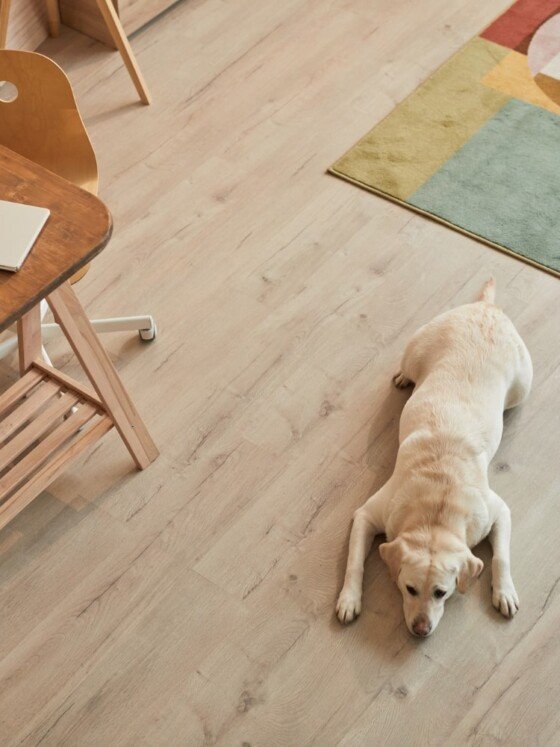Welcome to the comprehensive guide on buying engineered wood flooring. This resource aims to provide essential information for beginners who are considering adding this durable and elegant flooring option to their homes. Engineered wood flooring offers the beauty of hardwood along with enhanced stability. In this guide, we will cover everything you need to know, including the basics of engineered wood flooring, tips for measuring and selecting the right choice, and calculating the total cost. Let’s get started!
Understanding Engineered Wood Flooring
Engineered wood flooring is a versatile and durable option that consists of multiple layers of wood. The top layer, known as the wear layer, is made of genuine hardwood, providing an authentic look and feel. Beneath the wear layer, there are high-density fibre board (HDF) or plywood layers that contribute to the flooring’s strength and stability. Engineered wood flooring is designed to withstand varying environmental conditions and can be used in any area of your home, making it an excellent choice for enhancing your floors.
Advantages of Engineered Wood Flooring
Engineered wood flooring offers numerous benefits that make it an appealing choice for homeowners.
Let’s explore some of these key advantages:
Durability: Engineered wood flooring is designed to be highly resistant to moisture, warping, and general wear and tear. Its layered construction makes it less susceptible to expansion and contraction caused by changes in temperature and humidity.
Versatility: With a wide range of styles, finishes, and colours, engineered wood flooring offers excellent versatility. You can choose an option that perfectly complements your desired aesthetic, whether it’s a classic, contemporary, or rustic look.
Stability: Engineered wood flooring’s layered construction makes it more stable than solid wood. This characteristic makes it an ideal choice for spaces like basements where maintaining consistent humidity levels can be challenging.
Easy Installation: Engineered wood flooring offers various installation methods, including click-lock and tongue-and-groove systems. These systems make installation easier for beginners or those who prefer a DIY approach.
Compatibility with Underfloor Heating: Engineered wood flooring is compatible with underfloor heating systems. Its layered construction allows for better heat distribution and reduces the risk of damage compared to solid wood flooring.
Measuring Tips for Engineered Wood Flooring Buyers
It is important to accurately measure your space before buying engineered wood flooring to avoid any wastage or shortage. Here’s how to measure before buying.
Calculate Square Footage: Measure the length and width of the room and multiply the two measurements to calculate the square footage. Divide them into smaller sections for irregularly shaped rooms and measure each separately.
Consider Wastage: It’s advisable to add a buffer for wastage when ordering engineered wood flooring. Generally, adding an extra 5-10% to the total square footage is recommended to account for cuts and mistakes during installation.
Direction and Layout: When choosing flooring, it’s important to think about the direction and layout you want it to run. This can have an impact on the appearance and layout of the room.
By measuring accurately and accounting for wastage, you can ensure a seamless and successful flooring project.
Discover the Best Flooring Option for Your Needs
Not all engineered wood flooring options are created equal. To determine which option is suitable for your specific needs, consider the following factors:
Wood Species: Engineered wood flooring is available in various wood species, each with unique characteristics. Consider colour, grain pattern, and hardness to select a species that aligns with your aesthetic preferences and lifestyle.
Finish and Texture: Determine the desired finish and texture of the flooring. Options range from smooth and polished to distressed and textured, allowing you to achieve your desired look and feel.
Thickness: The thickness of the wear layer and overall plank can vary. Thicker wear layers provide better durability and the option for future refinishing. Consider your needs, budget, and desired flooring lifespan when selecting the appropriate thickness.
Installation Method: Evaluate the installation methods available and choose one that suits your skill level and preferences. Click-lock systems are popular for their ease of installation, while tongue-and-groove systems may require professional assistance.
By considering these factors, you can select the engineered wood flooring option that best meets your requirements and vision for your space.
Useful Tips for Choosing Engineered Wood Flooring
Choosing the right engineered wood flooring can seem overwhelming, especially with the many options available. Here are some tips to help you make an informed decision:
Research and Compare: Take the time to research different brands, manufacturers, and retailers to find a reputable and reliable source for your flooring. Compare prices, warranties, and customer reviews to make an informed decision.
Request Samples: When considering different types of flooring, it is important to request samples to make an informed decision. By physically seeing and feeling the flooring’s quality, colour, and texture, you can better assess whether it will meet your needs and preferences. Requesting samples can help ensure that you are happy with your flooring choice and avoid any potential regrets in the future.
Consider Your Lifestyle: Consider your lifestyle and the level of foot traffic in the area where the flooring will be installed. Some wood species are more resistant to scratches and dents, making them suitable for high-traffic areas.
Read and Understand Warranties: Take the time to read and understand the warranties offered by the manufacturer. Pay attention to warranty duration, coverage, and any specific care and maintenance requirements.
Ask for Professional Advice: If you need clarification on any aspect of choosing engineered wood flooring, feel free to seek professional advice. Flooring experts can provide valuable insights and recommendations based on your specific needs.
Following these tips, you can make a well-informed decision when selecting your engineered wood flooring.
Buying and Installation Costs of Engineered Wood Flooring
When planning your budget for engineered wood flooring, it’s important to consider the total cost, including buying and installation expenses. Here’s a breakdown of potential costs.
Buying Cost
The buying cost refers to the price of the engineered wood flooring itself. Prices vary based on the wood species, quality, finish, and brand. On average, you can expect to spend anywhere between £ 25 to £ 100 per square meter for engineered wood flooring.
Installation Cost
The installation cost includes the labour required to install the flooring. The actual cost will depend on factors such as the installation’s complexity, the area’s size, and your location. On average, labour costs for installing wooden flooring start at around £15 to £20/m² on average, but most fitters charge £150 to £300 per day or project.
Additional Expenses
Additional expenses may be associated with engineered wood flooring, such as underlay, adhesives, transition pieces, and delivery fees. These costs can vary depending on your specific requirements and your chosen supplier.
By considering the buying cost, installation cost, and any additional expenses, you can estimate the total investment required for your engineered wood flooring project.
Conclusion
In conclusion, the Engineered Wood Flooring Buyers Guide provides valuable insights and information to assist you in selecting and purchasing the ideal engineered wood flooring. Understanding the construction, benefits, and factors to consider, such as measurement, suitability, and cost, is essential for making an informed decision. By conducting thorough research, comparing options, and seeking professional advice, you can confidently choose the perfect engineered wood flooring for your home.
FAQs
Can engineered wood flooring be installed in bathrooms?
Yes, engineered wood flooring can be installed in bathrooms, but choosing a product specifically designed for high-moisture areas is essential. Look for engineered wood flooring with a waterproof or water-resistant finish.
Can engineered wood flooring be refinished?
The ability to refinish engineered wood flooring depends on the thickness of the wear layer. Thicker wear layers allow for multiple refinishing processes, extending the lifespan of the flooring.
Is engineered wood flooring suitable for homes with pets?
Yes, engineered wood flooring is a suitable option for homes with pets. However, it’s advisable to choose a harder wood species and consider additional protective measures to prevent scratches from pet claws.
Can engineered wood flooring be installed over concrete slabs?
Yes, engineered wood flooring can be installed over concrete slabs. Ensure the concrete is clean, dry, and level before the installation begins.
How long does engineered wood flooring typically last?
With proper maintenance and care, engineered wood flooring can last for decades. The lifespan may vary depending on factors such as the thickness of the wear layer, the installation quality, and the foot traffic level.
Can I install engineered wood flooring, or do I need professional help?
Engineered wood flooring can be installed as a DIY project, especially with click-lock systems. However, if you need more experience, seeking professional help is recommended to ensure a proper and seamless installation.






Leave a Reply